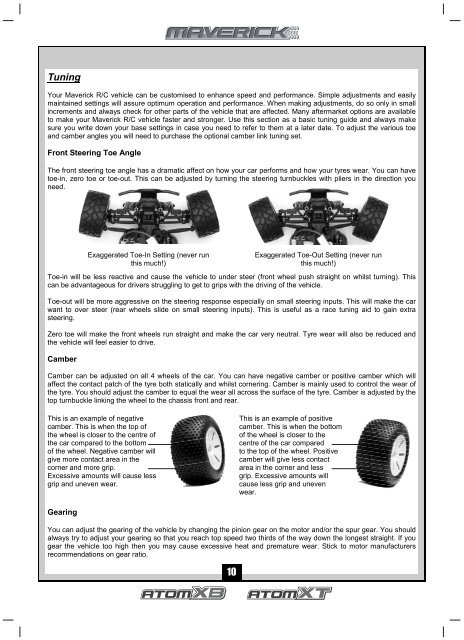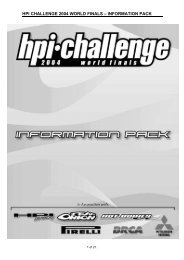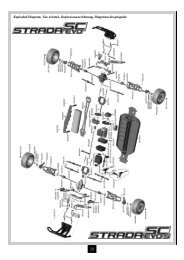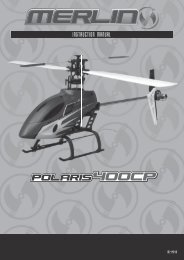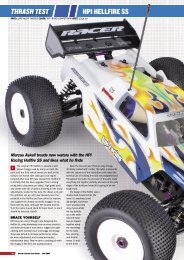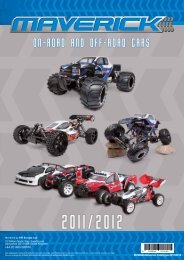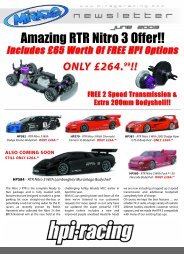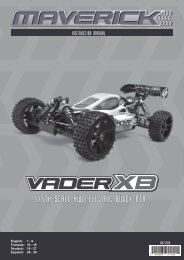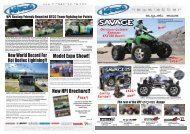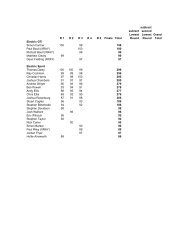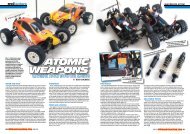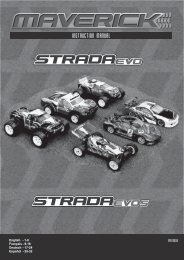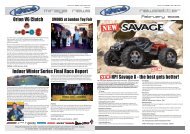Atom Manual EU Ver 2.pub - LRP
Atom Manual EU Ver 2.pub - LRP
Atom Manual EU Ver 2.pub - LRP
Create successful ePaper yourself
Turn your PDF publications into a flip-book with our unique Google optimized e-Paper software.
Tuning<br />
Your Maverick R/C vehicle can be customised to enhance speed and performance. Simple adjustments and easily<br />
maintained settings will assure optimum operation and performance. When making adjustments, do so only in small<br />
increments and always check for other parts of the vehicle that are affected. Many aftermarket options are available<br />
to make your Maverick R/C vehicle faster and stronger. Use this section as a basic tuning guide and always make<br />
sure you write down your base settings in case you need to refer to them at a later date. To adjust the various toe<br />
and camber angles you will need to purchase the optional camber link tuning set.<br />
Front Steering Toe Angle<br />
The front steering toe angle has a dramatic affect on how your car performs and how your tyres wear. You can have<br />
toe-in, zero toe or toe-out. This can be adjusted by turning the steering turnbuckles with pliers in the direction you<br />
need.<br />
Toe-in will be less reactive and cause the vehicle to under steer (front wheel push straight on whilst turning). This<br />
can be advantageous for drivers struggling to get to grips with the driving of the vehicle.<br />
Toe-out will be more aggressive on the steering response especially on small steering inputs. This will make the car<br />
want to over steer (rear wheels slide on small steering inputs). This is useful as a race tuning aid to gain extra<br />
steering.<br />
Zero toe will make the front wheels run straight and make the car very neutral. Tyre wear will also be reduced and<br />
the vehicle will feel easier to drive.<br />
Camber<br />
Camber can be adjusted on all 4 wheels of the car. You can have negative camber or positive camber which will<br />
affect the contact patch of the tyre both statically and whilst cornering. Camber is mainly used to control the wear of<br />
the tyre. You should adjust the camber to equal the wear all across the surface of the tyre. Camber is adjusted by the<br />
top turnbuckle linking the wheel to the chassis front and rear.<br />
Gearing<br />
Exaggerated Toe-In Setting (never run<br />
this much!)<br />
This is an example of negative<br />
camber. This is when the top of<br />
the wheel is closer to the centre of<br />
the car compared to the bottom<br />
of the wheel. Negative camber will<br />
give more contact area in the<br />
corner and more grip.<br />
Excessive amounts will cause less<br />
grip and uneven wear.<br />
Exaggerated Toe-Out Setting (never run<br />
this much!)<br />
This is an example of positive<br />
camber. This is when the bottom<br />
of the wheel is closer to the<br />
centre of the car compared<br />
to the top of the wheel. Positive<br />
camber will give less contact<br />
area in the corner and less<br />
grip. Excessive amounts will<br />
cause less grip and uneven<br />
wear.<br />
You can adjust the gearing of the vehicle by changing the pinion gear on the motor and/or the spur gear. You should<br />
always try to adjust your gearing so that you reach top speed two thirds of the way down the longest straight. If you<br />
gear the vehicle too high then you may cause excessive heat and premature wear. Stick to motor manufacturers<br />
recommendations on gear ratio.<br />
10


